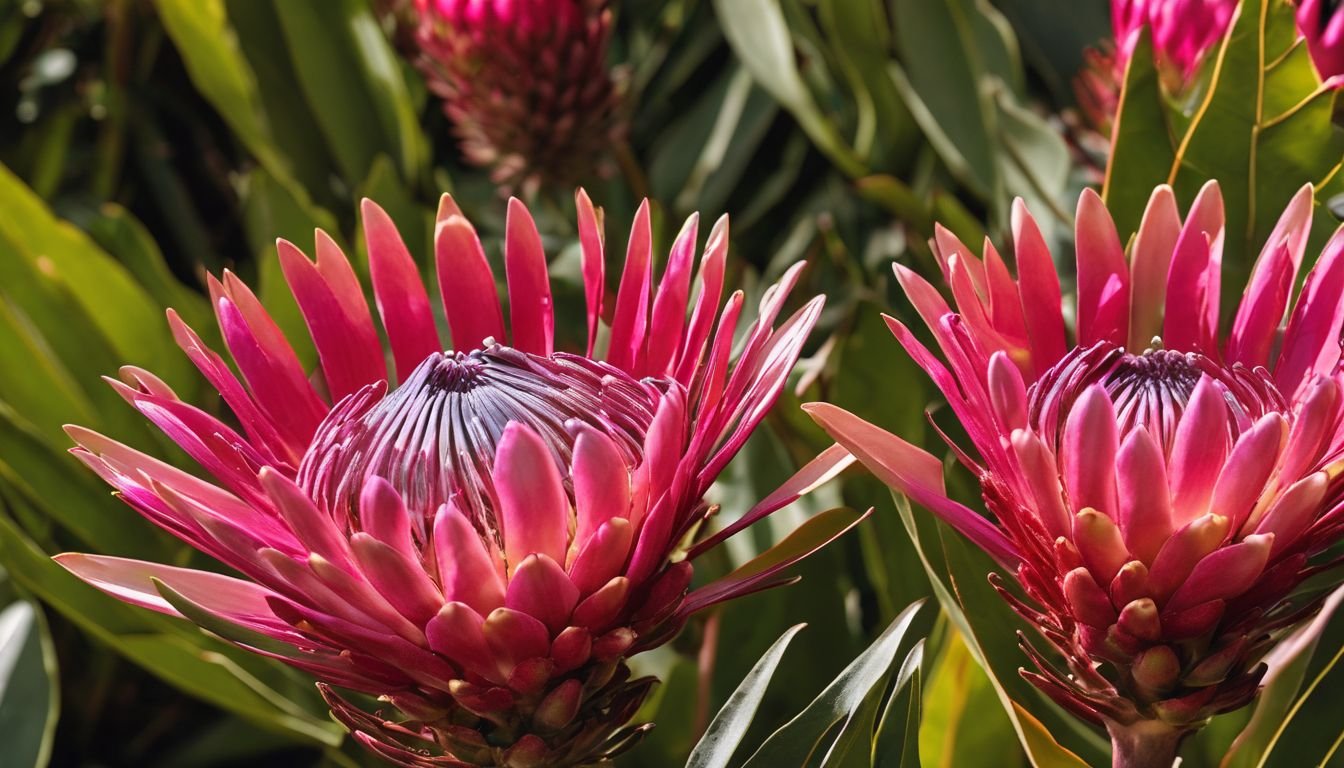Finding the perfect plants for your garden can be a challenge, especially when you’re looking for something unique and eye-catching. Protea flowers are a superb choice, famous for their striking appearance and variety.
This blog will guide you through the world of these beautiful blooms, offering tips on how to grow them successfully in Australia’s diverse climates. Discover the vibrant colours of protea today; let’s dig into their captivating world!
Key Takeaways
- Protea flowers, native to South Africa, are part of the diverse Proteaceae family and thrive in Australia thanks to their tolerance for various climates.
- Varieties like Protea Australis Ruby, Protea Juliet, and the compact Protea Little Prince (PBR) have become popular in Australian gardens for their beauty and low maintenance needs.
- These plants require well – draining soil with a neutral to acidic pH and benefit from sunlight exposure, proper watering, mulching, and careful pruning to promote health and vibrant blooms.
- Apart from adding aesthetic value to gardens, proteas contribute positively to local ecosystems by attracting pollinators such as bees.
- The king protea is a national symbol of South Africa representing diversity and strength; it thrives along with other varieties under Australian conditions.
Overview of Protea Flowers

Nestled within the rich tapestry of Australia’s flora, Protea flowers stand out with their bold textures and hues, a testament to the diversity and adaptability of the Proteaceae family.
These striking blooms, encompassing an array of species from towering trees to ground-hugging shrubs, have not only adapted to thrive in a variety of Australian conditions but also bring an exotic touch to gardens across the continent.
Origin and Family Roots
Proteas boast a rich heritage, tracing their roots back to the lush landscapes of South Africa where they are a national treasure. These robust flowering plants belong to the Proteaceae family, which includes familiar relatives like banksias, leucadendrons, and macadamias.
Gardeners appreciate proteas not only for their striking appearance but also for their resilience. They thrive in well-draining soil, coping admirably with both frost and drought once established.
Enthusiasts often plant proteas alongside other hardy species in gardens designed to celebrate nature’s tenacity. The king protea (Protea cynaroides), perhaps the most celebrated variety, serves as South Africa’s national flower and symbolises diversity and strength.
This emblematic bloom heads an impressive lineup that flourishes under full sun across different regions of Australia – all while contributing to a vibrant ecosystem where pollinated flowers nurture biodiversity year-round.
Varieties of Protea in Australia
- Protea Australis Ruby: Showcases large dusky pink flowers that make a bold statement in any garden. This hardy cultivar thrives in well-draining sandy or loamy soils enriched with organic matter, ensuring healthy growth.
- Protea Juliet: With red blossoms that delight gardening enthusiasts, this variety demands well-drained soil and benefits from regular pruning to promote air circulation and reduce fungal problems.
- Protea Little Prince (PBR): Distinguishable by its compact size, this plant is ideal for small spaces. It prefers a potting mix that mimics its natural habitat, meaning plenty of drainage and not too much moisture, safeguarding against root rot.
Symbolism and Cultural Significance of Protea Flowers

Proteas carry deep symbolism, embodying transformation and the enduring spirit of hope in many African cultures. Their striking appearance has led them to be associated with diversity and strength, a testament to their ability to flourish in challenging environments.
These flowers serve not just as botanical wonders but also as symbols of human resilience.
The king protea stands out among its kind, recognised as South Africa’s national flower. It reflects the nation’s rich cultural heritage and natural beauty. This bloom proudly represents elements of South Africa’s identity, celebrated for its grandeur and recognised worldwide as a symbol of this vibrant country’s landscape.
Cultivation and Care for Protea Plants
Understanding the nuances of cultivating protea plants is key for enthusiasts looking to add these striking blooms to their gardens. With their unique requirements, from frost tolerance to the need for well-draining sandy soil, success hinges on a gardener’s attention to detail and commitment to providing the right conditions that mirror their native Cape Floristic Region habitat.
Planting and Soil Preparation
Protea flowers thrive in Australian gardens with the right soil and planting techniques. Here are some essential steps for preparing the ideal environment for these stunning blooms:
- Choose a spot in your garden that gets plenty of sunlight; Proteas love the sun and require at least six hours of direct light every day.
- Test your soil to ensure it’s well – drained, with a neutral to acidic pH — this is crucial for healthy Protea plants. If necessary, amend your soil to achieve the correct pH balance.
- Look for sandy soil or add coarse sand to improve drainage; Proteas don’t do well in clay soil as their roots can rot when waterlogged.
- Create raised beds if you’re dealing with heavy earth or have concerns about drainage. This helps prevent standing water around Protea roots.
- Space your Protea plants adequately to ensure they have room to grow without competing for nutrients. They spread out as they mature.
- Plant young Proteas during milder weather conditions, avoiding extreme cold or heat, which can stress the plants.
- Dig holes twice as wide but just as deep as the root ball of your plants, providing enough space for roots to spread out comfortably.
- Refrain from adding high – fertility organic material like compost; these flowers prefer low fertility conditions similar to their native habitats in Cape Floristic Region.
- Employ regular deep watering after planting until your Protea plants become established. This encourages deeper root growth making them more frost tolerant over time.
- Lay a layer of organic mulch around the base of your plants; it conserves moisture and suppresses weeds without enriching the soil too much.
Maintenance and Pruning
- Water proteas deeply until they are fully established, ensuring that the soil is moist but not waterlogged.
- Continue with regular watering during periods of extreme heat to prevent wilting.
- Apply organic mulch around the base of the plant to keep the soil cool, suppress weeds, and protect the roots, which prefer not to be disturbed.
- Carefully pull any weeds by hand rather than digging around the plant to avoid damaging its shallow root system.
- Keep an eye out for signs of stress in your proteas, such as discoloured leaves or a lack of flowers, which may indicate a need for more or less water.
- Cut back your protea plants after they’ve bloomed; this encourages new growth and helps maintain their compact shape.
- Use clean, sharp pruning shears to make precise cuts just above new growth or bud nodes.
- Dispose of all cuttings and debris to reduce the risk of disease spread among your plants.
- If your pincushion proteas are planted in containers, consider using a slow – release fertiliser designed specifically for Australian native plants.
- Ensure pots have proper drainage holes to prevent water from pooling at the roots and causing rot.
Conclusion
Embrace the splendor and variety that Protea flowers bring to Australian gardens. These magnificent blooms not only add pops of color from Autumn to Spring but also stand tall as symbols of diversity and resilience.
With their unique shapes and hues, they carry a piece of South African heritage across the ocean to thrive in many environments Down Under. Garden enthusiasts will find joy in nurturing these hardy plants, and with patience, be rewarded by their stunning flowering display.
Let Proteas transform your outdoor space into an exotic retreat brimming with life.
Discover the similarly enchanting world of Grevillea flowers, another Australian native that captures the heart with its diverse forms and vibrant colours.
FAQs
1. What makes Protea flowers unique in Australia?
Protea flowers, such as the pin-cushion proteas and sugarbushes, boast an exceptional diversity with various cultivars thriving across different hardiness zones in Australia.
2. Are there any Protea plants native to Australia besides those from South Africa?
Indeed, Australia is home to its own spectacular species like waratahs which share a kinship with the national flower of South Africa, the leucospermum cordifolium.
3. Can I grow different types of Protea flowers in my Australian garden?
With proper knowledge about each plant’s needs, Australians can cultivate a range of proteas; for instance, herbaceous varieties like leucospermum reflexum require specific conditions but offer stunning blooms when cared for correctly.
4. What should I consider when selecting a Protea plant for my garden?
Factors like your garden’s hardiness zone and whether you prefer low-growing varieties or tall leucadendron argenteum trees are important considerations when choosing diverse and beautiful proteas for your outdoor space.
